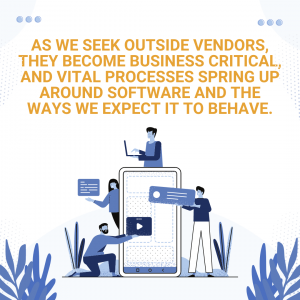Properly Utilizing Aging Vendor Applications

If your company needs a software, it doesn’t always make sense, practically or fiscally, to make that software internally. As we seek outside vendors, they become business critical, and vital processes spring up around software and the ways we expect it to behave. As time goes on, the people who initially chose the software leave the company, and new employees come who have never known a version of your business without this software. It becomes integral – an irreplaceable part of the team.
Unfortunately, as customers, we don’t typically have much control over our vendors or the product, and sometimes that can mean sudden, rapid, massive changes. Most commonly, this period of rapid change occurs after several years of stability, conveniently after the team members who created the architecture around the software have either moved roles or left the company entirely.
This precise situation occurred recently to one of our current clients. The third party software company was removing a data replication process that our client had come to rely on as part of not only their reporting, but also their day to day operations. The software company was not helpful in offering alternatives.
So they called us.
We are not software developers, but we pride ourselves as problem solvers and will offer any support to clients that we are able when they run into roadblocks, so, we got to work. We were able to get the vendor to agree to a linked server system, which would allow our client to still access the data they needed, and we offered to have our security experts or even our own CISO to oversee the process to ensure that the highest data security standards would be met.
That solved the access problem, but the result was substantially slower than the client had become accustomed to expecting from their data. We clearly did not close this case yet.
Next, we found the most heavily trafficked datasets and replicated them locally, allowing substantially faster speeds than the linked servers. At this point, the client would have been satisfied, but we thought we could do better.
So, we sent in our performance and tuning experts. Between indexing, query tuning, and proper data maintenance, we were able to ensure our clients data was not only accessible, but their reports that used to take several seconds to load were now instant, and their slow internal app became lightning fast.
Finally, the client was ecstatic, and we could consider this a job well done.



